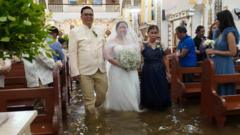Amid heavy rainfall and rising floodwaters, couples in the Philippines are embracing their wedding vows in flooded churches. Despite challenges, their resilience continues to be a shining example of love and commitment in the face of adversity.
Flooded Aisles: Filipino Couples Marry Amidst Rising Waters

Flooded Aisles: Filipino Couples Marry Amidst Rising Waters
As seasonal storms wreak havoc, couples in the Philippines persevere through flooded churches on their wedding days.
In the Philippines, wedding scenes often reflect resilience, especially when the nuptials take place in flooded churches. For Jamaica Aguilar and Jade Rick Verdillo, their recent wedding at Barasoain Church, submerged in water after heavy rains, was a testament to this spirit. Clad in a beautiful white gown and assisted by her father, Aguilar maneuvered through knee-deep water to reach the altar, showcasing an unwavering determination that has resonated with many on social media.
This situation is not new; Aguilar and Verdillo's wedding mirrored a similar experience two years prior at the same church, and another one occurred in 2018 in Bulacan province. These incidents highlight not only the couples’ tenacity but also point to a broader, tragic narrative of persistent flooding affecting millions, exacerbated by outdated sewage systems, poor urban planning, and increasingly severe weather events.
For the newlyweds, deciding to proceed with their ceremony amidst the flooding was a tough call, with the couple ultimately choosing to focus on the importance of their commitment. They expressed joy after the ceremony, immediately taking preventive antibiotics against potential flood-borne illnesses. While the celebration of love saw great heights, it was immediately juxtaposed with sorrow as hours later another funeral was held at the same, now-waterlogged, church.
As Typhoon Wipha, locally known as Crising, adds to the woes of the region, it marks the third storm to hit the Philippines this year, a country often battered by typhoons due to its geographical positioning. Tragically, the recent deluge brought loss of life and significant displacement, prompting urgent calls for government action.
Critiques of the government’s preparedness became apparent as President Ferdinand Marcos Jr. faced backlash over images showing public resources being misallocated for political stunts rather than disaster response. Experts have pointed to Metro Manila's aging and overwhelmed sewage systems, dating as far back as the early 1900s, as a key contributor to the recurring flooding crisis.
Looking toward solutions, the government is in collaboration with the World Bank to draft a comprehensive master plan aiming to tackle drainage issues and reduce flood risks. Newlywed Verdillo remains hopeful for the future, stressing the need for significant investment in infrastructure to avoid wading through water in future weddings—a sentiment shared by many. In a country rich with waterways, effective flood management could pave the way for a brighter future, free from the constraints of flooded ceremonies.
This situation is not new; Aguilar and Verdillo's wedding mirrored a similar experience two years prior at the same church, and another one occurred in 2018 in Bulacan province. These incidents highlight not only the couples’ tenacity but also point to a broader, tragic narrative of persistent flooding affecting millions, exacerbated by outdated sewage systems, poor urban planning, and increasingly severe weather events.
For the newlyweds, deciding to proceed with their ceremony amidst the flooding was a tough call, with the couple ultimately choosing to focus on the importance of their commitment. They expressed joy after the ceremony, immediately taking preventive antibiotics against potential flood-borne illnesses. While the celebration of love saw great heights, it was immediately juxtaposed with sorrow as hours later another funeral was held at the same, now-waterlogged, church.
As Typhoon Wipha, locally known as Crising, adds to the woes of the region, it marks the third storm to hit the Philippines this year, a country often battered by typhoons due to its geographical positioning. Tragically, the recent deluge brought loss of life and significant displacement, prompting urgent calls for government action.
Critiques of the government’s preparedness became apparent as President Ferdinand Marcos Jr. faced backlash over images showing public resources being misallocated for political stunts rather than disaster response. Experts have pointed to Metro Manila's aging and overwhelmed sewage systems, dating as far back as the early 1900s, as a key contributor to the recurring flooding crisis.
Looking toward solutions, the government is in collaboration with the World Bank to draft a comprehensive master plan aiming to tackle drainage issues and reduce flood risks. Newlywed Verdillo remains hopeful for the future, stressing the need for significant investment in infrastructure to avoid wading through water in future weddings—a sentiment shared by many. In a country rich with waterways, effective flood management could pave the way for a brighter future, free from the constraints of flooded ceremonies.





















